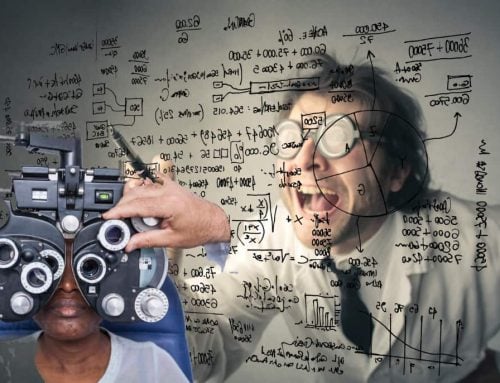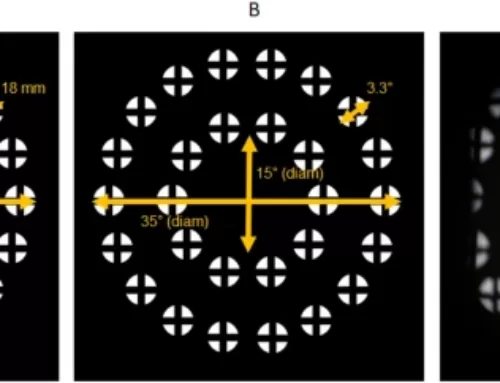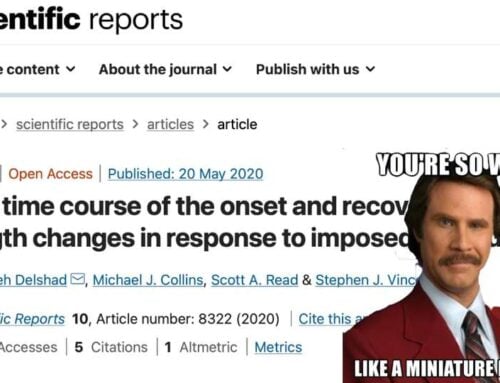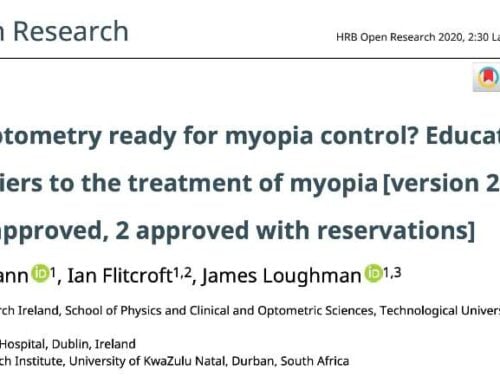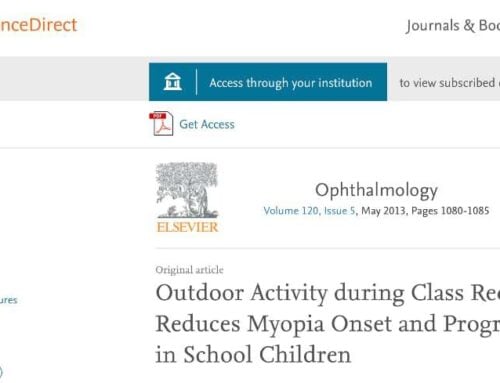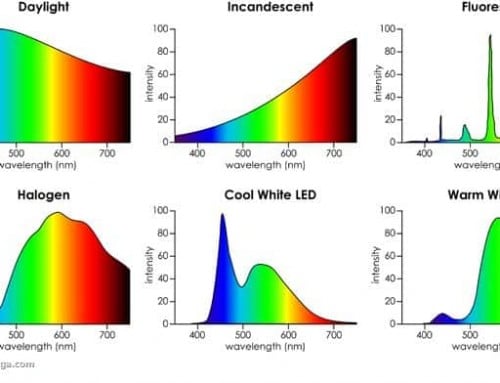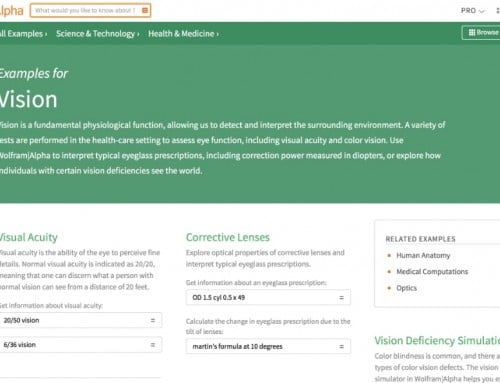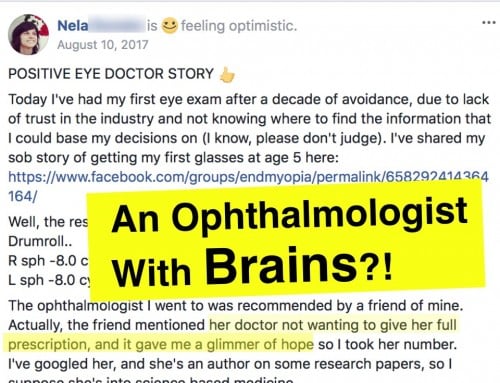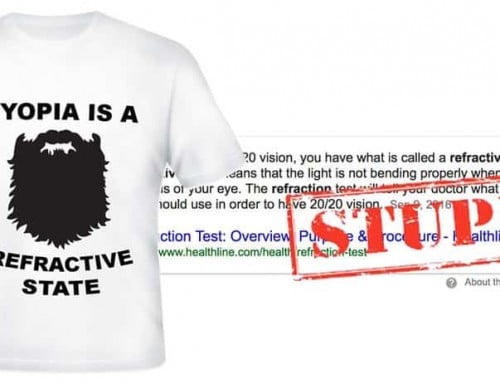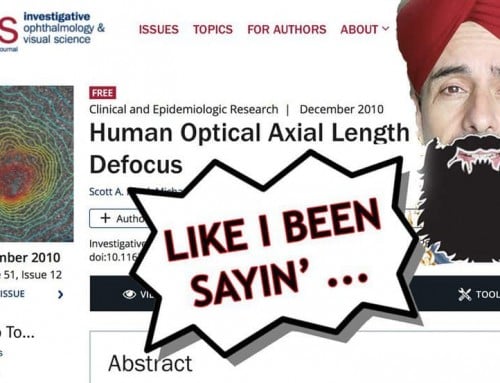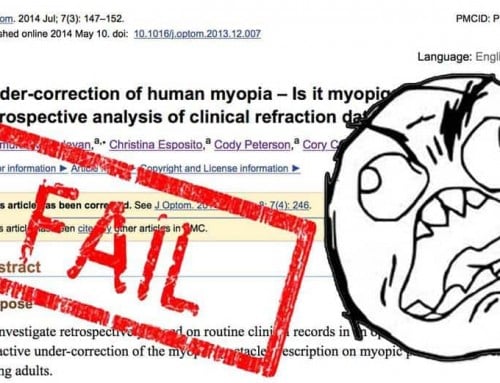Finally, my counterpoint to the previous article on why you shouldn’t trust us. ;)
In 2004, doctors Morgan and Megaw wrote an interesting dissertation, with no less than 59 excellent clinical and expert references. This dissertation went on to discuss what we know about axial elongation of the eye, and its role in the development of myopia.
Ready? Let’s dive in (the numbers indicate references, listed at the end of the article):
Introduction
Myopia in humans results from an imbalance between the refractive power of the cornea and lens and the axial length of the eye, such that the image of an object at infinity falls in front of the retina, with the lens at rest. Accommodation, therefore, cannot focus the blurred images of distant objects.
Theoretically, the problem could lie with excessively power optics, or excessive axial length, but population studies show that it is almost always excessive axial length that causes the problem. The increased axial length of the eye is the underlying cause of both the refractive error, which needs correction, and longer-term pathological sequelae, including an increased risk of potentially sight-threatening eye diseases such as cataract and glaucoma.1,2
High myopia is further associated with retinal detachment and degeneration, and a complex of other degenerative signs such as staphyloma, lacquer cracks, choroidal neo-vascularisation and choroido-retinal degeneration.3,4 While the immediate functional consequences of an excessively long eye can be corrected optically, this does not prevent the physiological stresses involved in maintaining a larger eye and retina, and as a result functional correction does not prevent the long-term pathological outcomes.
It is therefore clear that preventive approaches need to concentrate on measures that prevent or reduce axial elongation, since this would result in a reduction in both the need for refractive correction and the long-term pathological outcomes.
Genes and Environment in Myopia
There is considerable debate on the relative roles of genes and environment in the genesis of myopia.5-7
The rapid rate of change in the prevalence of myopia in East Asia, that is particularly well-documented in Singapore8 and Taiwan,9-11 rules out simple genetic explanations, since human gene pools do not change that fast. It is still possible that there are racial or ethnic predispositions towards developing myopia in particular environments. If this is the case, the effect is relatively small, since the differences in prevalence between racial groups are relatively narrow in the same environment, as is shown by data from Singapore on people of Chinese, Malay and Indian origin,12 particularly after adjustment for educational level.13 Both Indians12-16 and Malays12,13,17 have developed much higher prevalences of myopia in the environment of Singapore than in other countries.
This suggests that the predominant factors which are leading to the increased prevalence of myopia are environmental. Similarly, place of residence (urban or rural) has a major impact on the prevalence of myopia in closely genetically related populations in China,18-22 Taiwan9-11 and Nepal.23
Overall, the evidence available does not support the idea that the current increasing prevalences of myopia are due to genetically determined failures of emmetropisation, or to genetically determined racial or ethnic predispositions towards developing myopia in particular environments.
The Excessive Accommodation Theory
The dominant theory on the genesis of myopia is that excessive accommodation associated with close work places a load on the eye during development. This load can be reduced by increased growth of the eye. Unfortunately, this results in myopia. This theory has received substantial support from epidemiological studies that show a consistent link between near work and myopia.7,21,22,24-28
Although the evidence for a link is strong, attempts to make the link quantitative have been less successful, and it would appear that there are some parts of the picture missing. Possible thresholds and non-linearities in the link deserve further investigation. As the biological process of emmetropisation appears to involve adjusting eye length for viewing objects at a distance, and letting accommodation do the rest, the role of restricted distance vision is worth further exploration.
Experiments on animals show that imposing hyperopic defocus on an emmetropic eye leads to compensatory eye growth,29-34 which is also consistent with this theory. However, several experiments suggest that blocking accommodation by cutting the optic or ciliary nerves, or blocking transmission in the optic nerve with tetrodotoxin has little effect on the compensatory growth,35-40 which indicates that accommodation per se is not involved. This theory also appeared to receive substantial support from the ability of the muscarinic cholinergic agent atropine, known to block accommodation in humans, to block excessive eye growth and reduce myopic refractive error.41 It is also effective in animal models. However, it is now known that atropine appears to block eye growth in situations where it does not affect accommodation,42 suggesting that the drug is acting at another, as yet unknown, site.
There is considerable debate over the site and mechanism of action of atropine, and while it is clearly effective in clinical situations, these uncertainties mean that the use of atropine as a preventive requires further investigation, particularly in relation to potential long-term effects. Perhaps the biggest challenge to the excessive accommodation theory comes from the failure of optical interventions aimed at reducing accommodative load to prevent the development of myopia.
Interventions such as the use of reading glasses, bifocal and progressive lenses have been largely unsuccessful in preventing myopia.43-48
STOP and GO Signals in Eye Growth
Considerable work on animal models has demonstrated the existence of signals that decrease (STOP) and increase (GO) the rate of eye growth. These are most clearly seen in the response of eye growth to lenses, where imposed myopic defocus slows eye growth while imposed hyperopic defocus increases the rate of eye growth,29-34,36,49-51 and in the response of eye growth to removal of the diffuser in the form-deprivation model.38
There is some evidence that signals of this kind also operate during human emmetropisation.52 Considerable work has been devoted to elucidating the molecular, biochemical and cellular pathways which result in these growth signals (forreview,seeMorgan53).
Leaving aside the many questions about how many of these signals there are, and their molecular, biochemical and cellular basis, these sorts of signals provide an intuitive understanding of the process of emmetropisation. Since most animals, including humans, are born hyperopic, GO signals would be generated, that would decline in strength as emmetropia was approached. Thus eye growth would approach emmetropia as an endpoint. The recognition of the existence of STOP signals adds a further dimension to this picture, since STOP signals should be generated if eye growth takes the eye past emmetropia to myopia, correcting through control of eye growth any myopic refractive errors that are generated during development.
This understanding faces us with a conundrum. The process of emmetropisation appears to be doubly designed to achieve emmetropia through declining GO signals as emmetropia is approached, and STOP signals which should block the development of myopic refractive errors.
Yet it is clear that myopia is becoming more common, not as a result of genetically determined failures of emmetropisation, or of the GO and STOP growth signals, but as a result of environmental pressures. There are several possible explanations of why these signals may be failing. Since the animal models used involve the sudden imposition of quite high levels of myopic defocus, one possibility is that the gradual onset of human myopia means that there is never a sufficient stimulus to evoke a strong STOP signal. However, human myopes are exposed to bursts of myopic defocus whenever they remove their glasses or contact lenses, which ought to generate a STOP signal, unless these exposures do not reach a minimum critical time of myopic defocus required to generate STOP signals.”
—
First, interesting to note, plus and bifocals are often not successful in studies to prevent myopia. You wouldn’t think I would post something contracting #endmyopia here, right? But, wait!
STOP Signals are Rapidly Generated and Powerful
Recent studies have shown that the GO and STOP signals have very different properties.36,49,51,55
The generation of GO signals appears to require hours of exposure to hyperopic defocus, and they can be overcome by relatively brief (<3 hours) of normal vision.36,55 In contrast, STOP signals can be generated by relatively brief exposures to myopic defocus.36 Winawer and Wallman51 have shown that STOP signals can be detected in chickens after as little as 2 minutes of exposure to myopic defocus, provided that the animals were kept in the dark for the rest of the time. They have also shown that a period of myopic defocus is able to block the growth promoting effects of up to five times the period of hyperopic defocus. While keeping animals in the dark, except for the period of optical manipulation, does not provide a good paradigm for clinical use, these experiments show that STOP signals can be used to overcome quite strong growth promoting signals. Generation of STOP signals under more normal lighting conditions may require longer exposure,49 but the exposure times are still quite limited.
—
Stop and go signals, changing the length of the eyeball, to provide a correct focal plane. The eye as a dynamic system, responding to environmental stimulus Who knew? ;-)
But it gets even better.
Using STOP Signals to Block Eye Growth
While the natural STOP signals are clearly not effective during the development of human myopia, it is clear from the above analysis that this is unlikely to be due to a genetically determined failure in the process for generating such signals. We have, therefore, attempted to design a treatment regime that could block excessive axial elongation in chicken eyes which could be used in humans.
Based on the arguments outlined above, we fitted chickens with –5D contact lenses, which impose hyperopic defocus and cause compensatory increased eye growth. Removing these lenses for 1 hour every day for 10 days did not prevent increased axial elongation. In a parallel group of chickens, the –5D lenses were removed for 1 hour every day and replaced with +10D lenses. In these birds, excessive axial elongation was completely suppressed, and in fact the experimental eyes were smaller than the contralateral control eyes, suggesting that they might have become hyperopic.
In accord with the work of Wallman et al,51,56 these experiments suggest that, at least in chickens, plus lenses can be used to block optically induced drives towards excessive axial elongation. These experiments also indicate the importance of the degree of myopic defocus imposed on the eyes.
The compensatory growth response to the –5D lenses developed over the course of the experiment, and eyes with continuous exposure progressively elongated. In the birds where the –5D lens was removed, and normal vision was allowed for 1 hour, a similar development took place. Thus, when the lenses were removed, the animals were exposed to a rapid burst of increasingly significant myopic defocus, but this failed to prevent continued excessive axial elongation.
This situation is similar to that experienced by human myopes, as soon as their myopia is corrected. However, the imposition of additional myopic defocus to that dictated by the natural optics of the eye prevented continued axial elongation. The lack of effect of normal vision (albeit normal vision with myopic defocus) for 1 hour is not consistent with the evidence of the ability of relatively brief periods of normal vision to block the effects of minus lenses.36,55 Further work is required to resolve this issue.”
—
If you are still with me at this point, how do you feel? Are you enjoying some delicious science, to counter the vague-ities of the nay-sayers and the confounded?
Of course there is more interesting news. Let’s get back to the article:
Options for Controlling Human Myopia
More work is needed on animal models to validate this approach to preventing the development of myopia. It should be noted that there is evidence for similar GO and STOP signals in tree shrews and in non-human primates,29,57 although there are differences in the responses of the different animals to lenses of different powers.
The chicken eye appears to be able to respond accurately to a wider range of imposed lenses than can tree shrews and non-human primates, and attempts to use STOP signals to prevent excessive axial elongation in these animals have not yet been successful.58,59
However, further experimentation with lens of different powers may demonstrate the viability of this approach in mammalian and primate models. Some of the issues that need clarification are: 1. the duration of exposure to myopic defocus required to veto strong growth-promoting pressures, 2. the extent to which the ability of myopic defocus to generate STOP signals declines with age, 3. the dependence of STOP signals on the degree of myopic defocus imposed or lens power used, particularly in relation to the current refractive status of the eye and the myopic endpoint to which it is progressing, and 4. the time-course of STOP signals.
In general, non-invasive optical interventions to prevent myopia are preferable to drug therapies, such as those involving atropine and other muscarinic agents. Given the similarity in responses to minus and plus lenses of chicken, tree shrew and monkey eyes, there would appear to be a strong likelihood of finding an appropriate combination of variables such as age, lens power and duration of exposure that will prevent the development of myopia in children.”
—
Note the cautious tone of the article. And yet, with all the “oh we do need more studies”, look at all that glorious science! But what about lens-based therapy?
Let’s take a look:
There is a pleasing aspect to this perspective.
Given that STOP signals are generated by relatively short periods of imposed myopic defocus, it may be possible to develop clinical regimes of regular, but brief, use of plus lenses in spectacle frames.
These could be applicable to all children growing up in myopigenic environments, and could be delivered as part of the school routine. Early intervention would appear to be desirable, as would regular monitoring of eye development in all children.
The application of plus lenses and myopic defocus could then be delivered to children in a controlled regime in order to maintain children close to emmetropia, despite the environmental pressures. In this way, modern schooling, which appears to contribute to the development of myopia, may also provide the organisational basis for its ultimate prevention.”
—
Now look at that. Somebody should introduce these guys to Alex #endmyopia, and all of you who have found that “may be possible to develop clinical regimes” has indeed already happened. ;-)
Note that this applies specifically to prevention. The news that myopia reversal based on some of the theories mentioned in the article is already in action and working, would probably blow these guys’ minds. This site and everything you know, takes all the theory and discussion from research science, and applies it as working myopia rehab therapy.
There are exceedingly few resources like this, especially if you consider ongoing free content, the open support forum, and the many insightful therapist contributions.
We are gladly doing all this work for you!
We would also love to see some like numbers next to those social sharing buttons on posts like this one. It helps keep everybody here motivated, and not feeling like we are creating content into a void.
Share science. Share this article. It just takes one or two seconds: Hit the Facebook like button, or the Twitter button, or LinkedIn, or whichever social network you are part of. No single article will be heard alone, but if we just keep repeating the message, eventually it will make it through to people. I’d really like to see at least a few likes and shares, and in return we will keep bringing you science and strategies to get and keep your eyes health.
Thank you, and cheers!
– Jake Steiner
and References
1. Mitchell P, Hourihan F, Sandbach J, Wang JJ. The relationship between glaucoma and myopia: the Blue Mountains Eye Study. Ophthalmology 1999;106:2010-5. 2. Lim R, Mitchell P, Cumming RG. Refractive associations with cataract: the Blue Mountains Eye Study. Invest Ophthalmol Vis Sci 1999;40: 3021-6. 3. Tano Y. Pathologic myopia: where are we now? Am J Ophthalmol 2002;134:645-60. 4. Vongphanit J, Mitchell P, Wang JJ. Prevalence and progression of myopic retinopathy in an older population. Ophthalmology 2002;109: 704-11. 5. Saw SM, Chua WH, Wu HM, Yap E, Chia KS, Stone RA. Myopia: gene- environment interaction. Ann Acad Med Singapore 2000;29:290-7. 6. Saw SM, Katz J, Schein OD, Chew SJ, Chan TK. Epidemiology of myopia. Epidemiol Rev 1996;18:175-87. 7. Zadnik K. The Glenn A. Fry Award Lecture 1995. Myopia development in childhood. Optom Vis Sci 1997;74:603-8. 8. Seet B, Wong TY, Tan DT, Saw SM, Balakrishnan V, Lee LK, et al. Myopia in Singapore: taking a public health approach. Br J Ophthalmol 2001;85:521-6. 9. Lin LL, Chen CJ, Hung PT, Ko LS. Nation-wide survey of myopia among schoolchildren in Taiwan, 1986. Acta Ophthalmol Suppl 1988;185: 29-33. 10. LinLL,ShihYF,HsiaoCK,ChenCJ,LeeLA,HungPT.Epidemiologic study of the prevalence and severity of myopia among schoolchildren in Taiwan in 2000. J Formos Med Assoc 2001;100:684-91. 11. LinLL,ShihYF,TsaiCB,ChenCJ,LeeLA,HungPT,etal.Epidemiologic study of ocular refraction among schoolchildren in Taiwan in 1995. Optom Vis Sci 1999;76:275-81. 12. Au Eong KG, Tay TH, Lim MK. Race, culture and myopia in 110,236 young Singaporean males. Singapore Med J 1993;34:29-32. 13. Wu HM, Seet B, Yap EP, Saw SM, Lim TH, Chia KS. Does education explain ethnic differences in myopia prevalence? A population-based study of young adult males in Singapore. Optom Vis Sci 2001;78: 234-9. 14. Dandona R, Dandona L, Naduvilath TJ, Srinivas M, McCarty CA, Rao GN. Refractive errors in an urban population in Southern India: the Andhra Pradesh Eye Disease Study. Invest Ophthalmol Vis Sci 1999;40:2810-8. 15. Dandona R, Dandona L, Srinivas M, Giridhar P, McCarty CA, Rao GN. Population-based assessment of refractive error in India: the Andhra Pradesh eye disease study. Clin Exp Ophthalmol 2002;30:84-93. 16. Dandona R, Dandona L, Srinivas M, Sahare P, Narsaiah S, Munoz ZR, et al. Refractive error in children in a rural population in India. Invest Ophthalmol Vis Sci 2002;43:615-22. 17. Saw SM, Gazzard G, Koh D, Farook M, Widjaja D, Lee J, et al. Prevalence rates of refractive errors in Sumatra, Indonesia. Invest Ophthalmol Vis Sci 2002;43:3174-80. 18. ZhanMZ,SawSM,HongRZ,FuZF,YangH,ShuiYB,etal.Refractive errors in Singapore and Xiamen, China – a comparative study in school children aged 6 to 7 years. Optom Vis Sci 2000;77:302-8. 19. Zhao J, Pan X, Sui R, Munoz SR, Sperduto RD, Ellwein LB. Refractive error study in children: results from Shunyi District, China. Am J Ophthalmol 2000;129:427-35. 20. Zhao J, Mao J, Luo R, Li F, Munoz SR, Ellwein LB. The progression of refractive error in school-age children: Shunyi district, China. Am J Ophthalmol 2002;134:735-43. 21. Saw SM, Hong RZ, Zhang MZ, Fu ZF, Ye M, Tan D, et al. Near-work activity and myopia in rural and urban schoolchildren in China. J Pediatr Ophthalmol Strabismus 2001;38:149-55. 22. Saw SM, Zhang MZ, Hong RZ, Fu ZF, Pang MH, Tan DT. Near-work activity, night-lights, and myopia in the Singapore-China study. Arch Ophthalmol 2002;120:620-7. 23. Garner LF, Owens H, Kinnear RF, Frith MJ. Prevalence of myopia in Sherpa and Tibetan children in Nepal. Optom Vis Sci 1999;76:282-5. 24. Mutti DO, Mitchell GL, Moeschberger ML, Jones LA, Zadnik K. Parental myopia, near work, school achievement, and children’s refractive error. Invest Ophthalmol Vis Sci 2002;43:3633-40. 25. ZadnikK,SatarianoWA,MuttiDO,SholtzRI,AdamsAJ.Theeffectof parental history of myopia on children’s eye size. JAMA 1994;271: 1323-7. 26. Saw SM, Wu HM, Seet B, Wong TY, Yap E, Chia KS, et al. Academic achievement, close-up work parameters, and myopia in Singapore military conscripts. Br J Ophthalmol 2001;85:855-60. 27. Saw SM, Hong CY, Chia KS, Stone RA, Tan D. Nearwork and myopia in young children. Lancet 2001;357:390. 28. Saw SM, Chua WH, Hong CY, Wu HM, Chan WY, Chia KS, et al. Nearwork in early-onset myopia. Invest Ophthalmol Vis Sci 2002;43: 332-9. 29. Hung LF, Crawford ML, Smith EL. Spectacle lenses alter eye growth and the refractive status of young monkeys. Nat Med 1995;1:761-5. 30. Irving EL, Callender MG, Sivak JG. Inducing myopia, hyperopia, and astigmatism in chicks. Optom Vis Sci 1991;68:364-8. 31. IrvingEL,SivakJG,CallenderMG.Refractiveplasticityofthedeveloping chick eye. Ophthalmic Physiol Opt 1992;12:448-56. 32. Irving EL, Callender MG, Sivak JG. Inducing ametropias in hatchling chicks by defocus – aperture effects and cylindrical lenses. Vision Res 1995;35:1165-74. 33. Schaeffel F, Glasser A, Howland HC. Accommodation, refractive error and eye growth in chickens. Vision Res 1988;28:639-57. 34. Schaeffel F, Howland HC. Properties of the feedback loops controlling eye growth and refractive state in the chicken. Vision Res 1991;31:717-34. 35. McBrien NA, Moghaddam HO, Cottriall CL, Leech EM, Cornell LM. The effects of blockade of retinal cell action potentials on ocular growth, emmetropization and form deprivation myopia in young chicks. Vision Res 1995;35:1141-52. 36. Schmid KL, Wildsoet CF. Effects on the compensatory responses to positive and negative lenses of intermittent lens wear and ciliary nerve section in chicks. Vision Res 1996;36:1023-36. January 2004, Vol. 33 No. 1 Preventing Myopia by Natural STOP Growth Signals—I Morgan & P Megaw 19 20 Preventing Myopia by Natural STOP Growth Signals—I Morgan & P Megaw 37. Troilo D, Gottlieb MD, Wallman J. Visual deprivation causes myopia in chicks with optic nerve section. Curr Eye Res 1987;6:993-9. 38. Troilo D, Wallman J. The regulation of eye growth and refractive state: an experimental study of emmetropization. Vision Res 1991;31: 1237-50. 39. WallmanJ,WildsoetC,XuA,GottleibMD,NicklaDL,MarranL,etal. Moving the retina: choroidal modulation of refractive state. Vision Res 1995;35:37-50. 40. Wildsoet C, Wallman J. Choroidal and scleral mechanisms of compensation for spectacle lenses in chicks. Vision Res 1995;35: 1175-94. 41. Bedrossian RH. The treatment of myopia with atropine and bifocals: a long-term prospective study. Ophthalmology 1985;92:716. 42. McBrien NA, Moghaddam HO, Reeder AP. Atropine reduces experimental myopia and eye enlargement via a nonaccommodative mechanism. Invest Ophthalmol Vis Sci 1993;34:205-15. 43. Brown B, Edwards MH, Leung JT. Is esophoria a factor in slowing of myopia by progressive lenses? Optom Vis Sci 2002;79:638-42. 44. Leung JT, Brown B. Progression of myopia in Hong Kong Chinese schoolchildren is slowed by wearing progressive lenses. Optom Vis Sci 1999;76:346-54. 45. Gwiazda J, Hyman L, Hussein M, Everett D, Norton TT, Kurtz D, et al. A randomized clinical trial of progressive addition lenses versus single vision lenses on the progression of myopia in children. Invest Ophthalmol Vis Sci 2003;44:1492-500. 46. Edwards MH, Li RW, Lam CS, Lew JK, Yu BS. The Hong Kong progressive lens myopia control study: study design and main findings. Invest Ophthalmol Vis Sci 2002;43:2852-8. 47. Shih YF, Hsiao CK, Chen CJ, Chang CW, Hung PT, Lin LL. An intervention trial on efficacy of atropine and multi-focal glasses in controlling myopic progression. Acta Ophthalmol Scand 2001;79: 233-6. 48. Saw SM, Gazzard G, Au Eong KG, Tan DT. Myopia: attempts to arrest progression. Br J Ophthalmol 2002;86:1306-11. 49. Kee CS, Marzani D, Wallman J. Differences in time course and visual requirements of ocular responses to lenses and diffusers. Invest Ophthalmol Vis Sci 2001;42:575-83. 50. Miles FA, Wallman J. Local ocular compensation for imposed local refractive error. Vision Res 1990;30:339-49. 51. Winawer J, Wallman J. Temporal constraints on lens compensation in chicks. Vision Res 2002;42:2651-68. 52. GwiazdaJ,ThornF,BauerJ,HeldR.Emmetropizationandtheprogression of manifest refraction in children followed from infancy to puberty. Clin Vis Sci 1993;8:337-4. 53. Morgan IG. The biological basis of myopic refractive error. Clin Exp Optom 2003;86:276-88. 54. Goss DA, Cox VD. Trends in the change of clinical refractive error in myopes. J Am Optom Assoc 1985;56:608-13. 55. Shaikh AW, Siegwart JT Jr, Norton TT. Effect of interrupted lens wear on compensation for a minus lens in tree shrews. Optom Vis Sci 1999;76:308-15. 56. ZhuX,WinawerJA,WallmanJ.Potencyofmyopicdefocusinspectacle lens compensation. Invest Ophthalmol Vis Sci 2003;44:2818-27. 57. NortonTT,SiegwartJTJr.Animalmodelsofemmetropization:matching axial length to the focal plane. J Am Optom Assoc 1995;66:405-14. 58. Kee CS, Hung LF, Qiao Y, Ramamirtham R, Winawer JA, Wallman J, et al. Temporal constraints on experimental emmetropization in infant monkeys. Invest Ophthalmol Vis Sci 2002;43:E-Abstract 2925. 59. SiegwartJT,NortonTT.Whenviewingdistanceiscontrolled,whichlens power competes most effectively to slow myopic compensation to a –5D lens? Invest Ophthalmol Vis Sci 2002;43:E-Abstract 185. Annals Academy of Medicine


